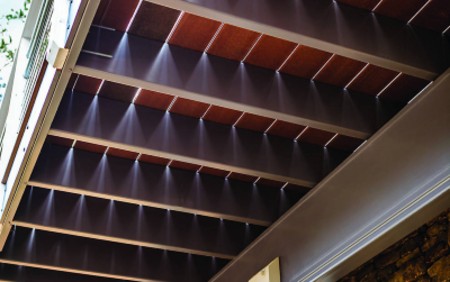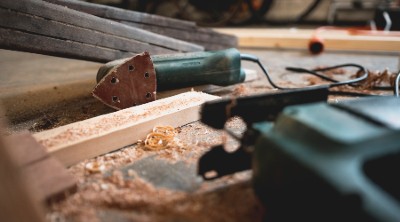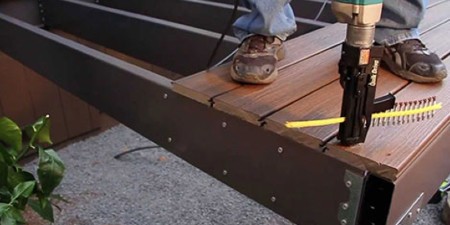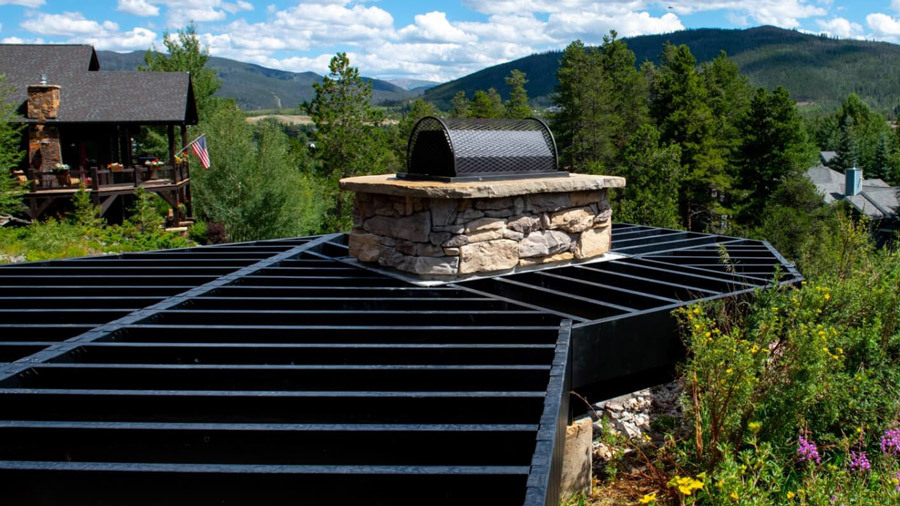Squaring Up Your Deck Frame
From hosting parties to enjoying the quiet of nature in the morning; adding a strong, outdoor space to your home is always a good choice. A new deck build increases both the monetary value, overall quality of life, and curb appeal of your living place all at once. A crucial structural factor to check in your existing deck space or new deck build is that your deck frame is squared up properly against your home. Knowing how to square a deck is critical.
Attaching to the ledger board of your home, deck frames should be squared up and plumb against the house or structure. This will provide a more secure hold throughout the years, less deck sway, easier decking installation, and minimal deck board waste to keep budgets low.
Here are some tips on how to build a squared deck frame and how to check if your deck frame is squared properly.
Using the 3-4-5 Rule to Find a Square
The 3-4-5 rule is a simplified way of referring to the Pythagorean theorem. Remember when teachers told you it would help you in real life? Turns out they might have been right! Using basic Mason's Strings, String Lines, or Nylon Rope you can check that your deck framing is square and plumb. If you want to know how to square a deck, 3-4-5 is the way to go.
The basics of the 3-4-5 rule states that if the shortest side of a triangle measures 3 feet long. and the leg extending outwards from it at 90° measures 4 feet long, then the longest side of the triangle will measure 5 feet long.
This well-known measuring technique can be multiplied out to achieve different triangle measurements to fit
your project while still achieving a 90-degree angle. These larger examples include:
And so on! You can multiply this same equation out until you find the exact size you're looking to work with. This can help increase accuracy when attaching on larger walls or when fastening more involved structures. Knowing how to square up a deck frame using this method can save a lot of headache.
The genius of this deck building technique is that it simply requires the DIY-builder or contractor to create a triangle.
How to Use the 3-4-5 Rule to Build Square Corners
With your deck frame set in place, but not fastened together completely, measure the top of the ledger board 3 feet away from the corner. Mark this location. Then, on the top of the side rim joist, measure 4 feet out from the corner. Mark this location.
Extend your tape measure between the two marks and slowly move the rim joist from side to side until the marks are exactly 5 feet apart. At this point, the two pieces are square.
Larger triangles, with sides of 6-8-10 and 9-12-15, will yield even more accurate results. Once your deck corners have passed the initial 3-4-5 test check, we recommend trying out the larger combinations for an additional peace of mind.
How to Square a Deck with a String
Learning how to square a deck with a string is straightforward. In fact, using a string line is one of the simplest ways to ensure your deck frame is square. Start by running a taut string along the ledger board and extending it to where the outer edge of the deck will be. Set up another string perpendicular to this, creating a rough outline of your deck’s shape. Use the 3-4-5 rule to check for squareness and adjust until the diagonal measures exactly 5 feet. Once squared, secure stakes at each corner and recheck before framing.
How to Check If Your Existing Deck Frame is Square
Experiencing some unsightly gapping between the decking and ledger boards? Feeling some unusual movement in that area of your deck? It's possible that your deck frame wasn't built properly squared. It also may have shifted over time and exhibits loose structural hardware. These are a few of the typical reasons why you may be working with a non-square or plumb deck frame.
Check your deck frame using two tape measures. This method only works on deck structures that feature symmetrical sizing.
Standard square or rectangular decks will require you to measure diagonally from corner-to-corner on both sides. These measurements should be exactly equal. For more unique deck shapes and designs such as octagons or hexagons, you will want to select two equal distances from opposite sides of the polygon.
Obviously, the more square the frame, the better. Slight tolerances can be adjusted before the joists are installed to prevent exaggeration. Compare the opposite lengths of the perimeter of squares and rectangle forms - these lengths should be the same. Using a square and a 4’ level will also help verify that your deck form is level.
Common Mistakes to Avoid When Squaring a Deck Frame
Getting your deck frame squared up is a critical step in ensuring a stable, long-lasting structure. Knowing how to square a deck is key. But even seasoned builders can run into trouble if they rush the process or overlook essential details. An out-of-square frame can cause all kinds of headaches, from uneven deck boards to misaligned railings and long-term structural issues. To save yourself frustration - and costly fixes down the road - watch out for these common mistakes when squaring your deck frame.
1. Rushing the Squaring Process
It's tempting to move quickly through framing so you can start installing decking, but failing to take the time to properly square the frame can lead to long-term problems. Double-check your measurements, adjust as needed, and ensure everything is aligned before locking it in place.
2. Not Double-Checking Squareness After Adjustments
Even if you squared the frame initially, small shifts can happen when securing joists, tightening bolts, or attaching the frame to the ledger board. Always measure again after making adjustments to confirm that your deck is still square before moving on.
3. Ignoring Small Discrepancies
A deck frame that's just slightly off might not seem like a big deal at first, but even a small misalignment can cause noticeable issues once decking boards, railings, and stairs are installed. Slight deviations can compound over time, making gaps more visible and creating uneven edges.
4. Misaligning the Ledger Board
Since the ledger board acts as the anchor point for your deck, any misalignment here will throw off the entire frame. Ensure that the ledger board is level and securely fastened to the house before measuring and framing the rest of the deck.
5. Failing to Check for Joist Warping or Twisting
Lumber can have natural imperfections, and using warped or twisted joists can make squaring the frame a nightmare. Inspect all framing materials before installation and replace any boards that aren't straight.
6. Neglecting Temporary Bracing
Without proper bracing, deck frames can shift slightly while you're securing them. Using temporary diagonal braces between joists or posts can help maintain squareness and prevent unintended movement.
7. Overlooking Foundation and Support Post Placement
If the footings and support posts aren't aligned correctly, it can throw off the entire frame. Before securing the deck frame, check that post bases are level and properly spaced to support a square structure.
Now that you know how to square a deck and what mistakes to avoid, you can save yourself a lot of time and frustration while ensuring your deck remains level, stable, and visually appealing for years to come.
Frequently Asked Questions About How To Square a Deck
Even though you know how to square a deck, you may still have additional questions. Here are some common things people ask.
Can I square a deck frame after installing the joists?
It's much harder to adjust squareness once the joists are installed, but not impossible. If you discover an issue, you may need to loosen some fasteners and slightly shift the frame. For minor corrections, adding diagonal bracing can help pull the frame into alignment. If the issue is severe, you may need to remove some joists and realign the perimeter.
How do I square a deck frame on uneven ground?
If you're building on sloped or uneven ground, start by ensuring your footings and posts are level. Use string lines and a laser level to maintain consistency. If adjustments are needed, use shims or adjustable post bases to correct height differences before framing. Once your support posts are level, you can square the frame.
Why is my deck frame square but my deck boards still look misaligned?
Even if your frame is perfectly square, deck board alignment can be thrown off by:
- Uneven joist spacing or warped joists.
- Improper fastening techniques, causing boards to shift.
- Failing to use chalk lines or spacers when installing decking.
To prevent this, check joist alignment before installation and snap a chalk line as a guide for laying boards evenly.
Knowledge Center
Tips and tricks on deck building and designing from the experts here at DecksDirect!







